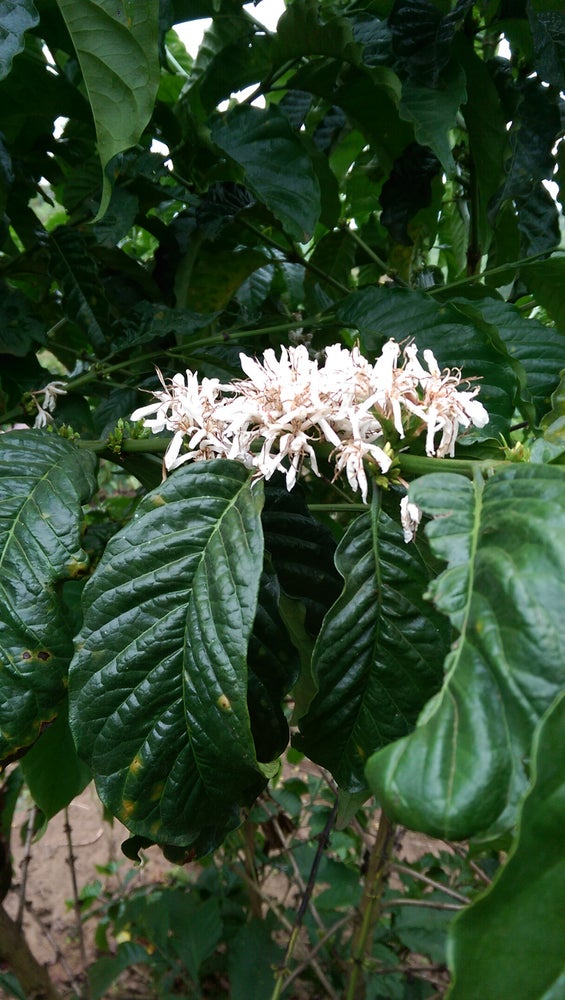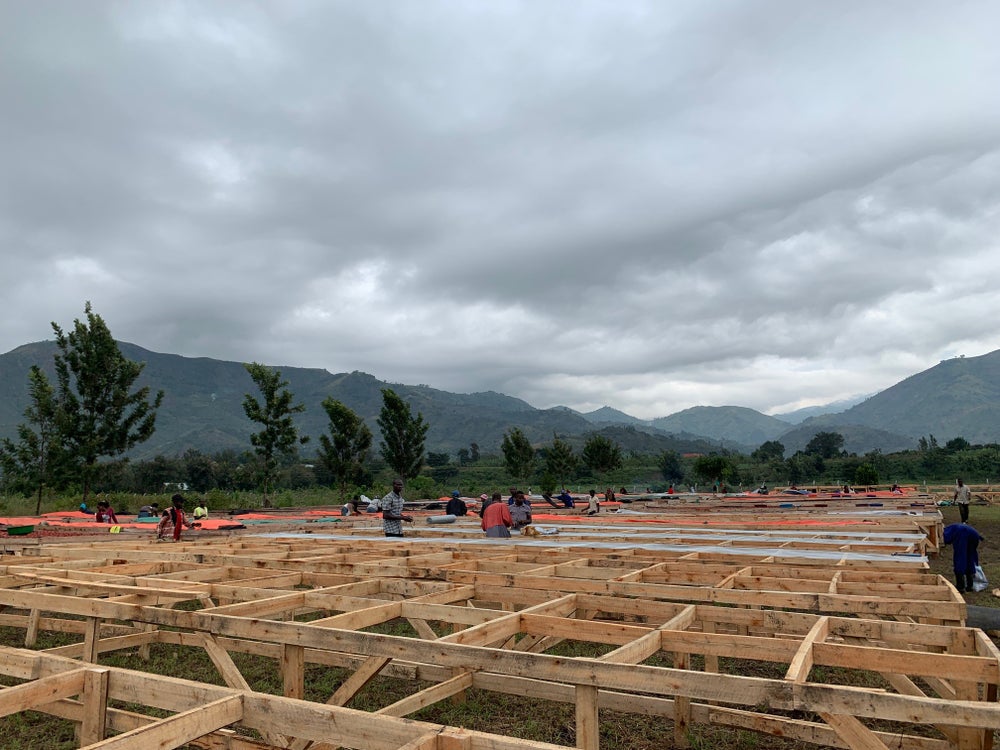

Uganda
Uganda is the native home to one species of Robusta, and commercial coffee production in the country goes back to the beginning of the 20th century. Today, our sister company, Ugacof/Sucafina Uganda, is optimizing Uganda’s strong potential for specialty Arabica production by focusing on agricultural extension and improved processing infrastructure.
Details
- Place In World Production:
- #7
- Average Annual Production:
- 5,000,000 (in 60kg bags)
- Common Arabica Varieties:
- Kent, Typica, SL-14, SL-28
- Key Regions:
- Bugisu (Mt. Elgon) | Lake Victoria basin | Western Uganda | West Nile
- Harvest Months:
- October– February (Main crop) | April–August (Fly crop)
Offers
Coffee History
Robusta once grew wild along the northern shores of Lake Victoria. The coffee was popular among the Baganda people, whose Buganda Kingdom was dominant in the Lake Victoria region from the 1840s through to the 1890s, when King Mwanga II signed a treaty with Britain establishing Buganda as a protectorate of the British East Africa Company.
Bagandans domesticated wild Robusta and cultivated it in their household gardens. Robusta also held important cultural significance and was mainly used for traditional and cultural ceremonies.
When Europeans arrived in East Africa, they saw the dual potential of Robusta plants and the region’s fertile earth. They endeavored to make all the separate kingdoms and groups governable as a single entity by neutralizing religious and cultural differences. One of the ways they did this was by gradually minimizing the importance of Robusta in Bagandan culture. Colonizers told Bagandans that it was unhealthy to drink coffee or chew the beans. As Robusta lost significance in the culture, the British began commoditizing it.
Arabica Arrives
European and Asian settlers brought Arabica varieties to Uganda. By 1914, they had established the first plantations in the country. At the same time the British colonial government was establishing plantations for large-scale Robusta cultivation, they were also introducing the Arabica varieties that were growing in neighboring Ethiopia and Malawi.
In the early days, coffee farms were mostly located across Central Uganda. The lower lying lands of this central region would prove to be ideal for the cultivation of Robusta. Nonetheless, the early days were rocky. Many of the earliest British-owned estates collapsed during the 1920’s, when the weight of falling prices was compounded by the end of World War I and the Spanish Flu epidemic.
The dissolution of British owned plantations left a vacuum in Ugandan coffee production. Ugandan smallholders stepped in to fill the void and became the major producers of both Robusta and Arabica coffee in the country.
By the turn of the twenty-first century, almost 20% of Uganda’s population earned most or all of their cash income from coffee. And the impact of coffee only continued to grow. From 1996 to 2000, coffee comprised nearly 60% of all export revenues.
Of course, most of this growth was in Robusta - the hardier and easier to grow species. Arabica played a supporting role within Uganda for over a century after its introduction. Though Arabica production has expanded, the ratio of Robusta to Arabica production nationwide is still about 80:20. Despite the importance of coffee to the country’s agricultural GDP, the specialty sector never quite laid its claim in the way that the commercial Robusta crop had. Until recently.
Arabica Production Expands
Beginning in the early 1990s with the liberalization of the coffee industry, a combination of increased leadership and investment in the coffee sector allowed people to begin seriously cultivating and earning money from Arabica. Most of this investment took place in Mount Elgon in the East and the Rwenzori mountains in the West because the conditions are virtually ideal for growing Arabica. In the east, the fertile volcanic soil surrounding Mount Elgon volcano makes for productive coffee farms, and to the west, the Rwenzori mountains offer high altitudes perfect for Arabica.
While these two regions of production are not entirely unknown in the coffee world, a lack of formal infrastructure meant that farmers had few choices but to produce home processed naturals, known locally as DRUGAR (Dry Ugandan Arabica: A type of Natural process where farmers dry unsorted cherry on the ground in the small spaces they have available to them) and WUGAR (the semi-washed version of DRUGAR).
Although the sector remains unprepared to support widespread quality washed processing, a recent push from the government and private investors has seen the building of new washing stations around these Arabica producing regions, opening the door to specialty production in these areas.
Uganda is targeting an overall increase in production of 20-25% by 2030. This can be a good thing for the region. It is important to focus on stabilizing prices, improving incentives for producers, and developing the skill sets and professional practices of the local workforce.
Coffee in Uganda today
The farm structure in Uganda is similar to Ethiopia and Kenya. Around 5 million people—or 1.7 million households—are employed in the coffee sector. Coffee is Uganda’s largest export commodity and is worth $550 million annually. Since 85% of all coffee grown is cultivated by smallholders with fewer than 2.5 hectares, Uganda has an immense potential to produce high quality, small lot specialty coffees.
Because most farms are owned by families who are also growing subsistence crops and overall productivity remains low, almost ¾ of the population is employed in agriculture. Such families are faced with difficult choices and a lot of guesswork to determine the best way to use their small plots of land. Too much of a cash crop and, in low price years, they go hungry. Not enough, and they cannot pay their bills. So, like Ethiopia, Ugandan smallholders typically intercrop their coffee with traditional food crops.
Most farmers producing washed coffees use hand pulpers. Newer initiatives to make eco-friendly integrated pulping systems more widely available are underway. Washed Arabicas from the Western areas are typically marketed as “WUGAR”. Those coming from the East are usually called Bugisu or Bugishu. Bugisu is in high demand for its winey, fruity, traditionally East African cupping notes. Both regions are demonstrating a substantial potential for even higher quality.
Arabica and Economic Growth
Coffee yields have remained low due to a lack of inputs and knowledge on proper growing practices. Increasingly, farmers are employing more Good Agricultural Practices and seeing results. There is a growing trend where successful coffee farmers purchase plots from other smallholders that have been less successful with quality coffee production. The new owners are leveraging their knowledge and dedication to reanimate the trees and land.
Annexing additional lands means improvement for both farmers and quality. With more land, farmers have space to nurture coffee trees and plant subsistence crops for their families. With a larger, more secure income, farmers can invest time and money in improving infrastructure and production, and even experimenting with new cultivation and processing methods. On a bigger plot, farmers can afford to stump unproductive trees, renew rootstock and allow land to lie fallow.
Though Arabica still accounts for only a small portion of total coffee production there’s a growing focus in the country on specialty coffee. Considering coffee’s financial impact in Uganda, it made sense that when President Yoweri Kaguta Museveni launched Operation Wealth Creation in July 2013, it focused on coffee—in addition to other agricultural crops—as a tool to improve livelihoods and speed up wealth creation in Uganda.
Operation Wealth Creation employs veterans to act as agricultural extension officers catering to coffee farmers. In addition to offering a wide variety of extension services, veterans distribute coffee seedlings and help create nurseries.
Sucafina in Uganda
Our partner, UGACOF/Sucafina Uganda is committed to improving quality in Uganda by building new washing stations and infrastructure and training personnel in the region. Collaborations with our FarmerHub program and our sustainability partner, the Kahawatu Foundation, are building upon our work to expand farmers’ access to better resources and better training. Our connections to our more established operations in nearby Rwanda, Burundi and Kenya offer us advice and a perspective steeped in familiarity with East Africa.
The bulk of our work in Uganda is focused in the West, near the Rwenzori Mountains. The biggest difference between East (Mount Elgon) and West (Rwenzori) is that Mount Elgon is a more established and competitive market. We are excited to be at the forefront of the drive for enhancing coffee production infrastructure, developing the industry and becoming reliable partners for farmers in the Rwenzori Mountain region.
It is clear to us that the potential in this region might exceed our expectations and even the potential of the popular Mount Elgon region. With an ever-growing demand for high-quality Arabicas and a sustained interest from roasters and coffee drinkers in the East African origins, we are very confident that, with diligence and effort, Western Ugandan coffees will be able to take their place alongside the other great East African coffees.
While the scale of work in regions like this can sometimes be overwhelming, we have a clear plan that steadily increases coffee quality.
Smallholder farmers contribute their cherry to washing stations. Given the altitude and microclimate, the cherry is high-quality. Due to a long history of home-processing and a lack of incentive for high quality, harvesting in the region is often semi- or entirely non-selective. Our first step is focused on improving coffee quality through processing by impacting harvesting techniques, leading to the most immediate and noticeable improvement.
Our Uganda team is applying the same rigorous QC standards that we see in Burundi and Rwanda. Thanks to our extended network of cherry collection sites, we meet with farmers every day during the harvest season and can give real-time feedback that can impact the quality of the next day’s harvest. At the collection sites, we can insist on higher levels of care and reward meticulous picking. Though we’re still in the early years, we have seen a clear difference in quality from one year to another and even from the first week of the harvest to the last.
This process also provides additional income for farmers who are now getting paid specialty prices for their cherry. Farmers get at least at 10% premium than if they were producing Drugar quality. The average farmer in Uganda gets 65 to 75% of the cost of FOB, which is higher than most other East African origins, except Kenya.
We are currently working with more than 8,000 farmers on farming practices, climate-smart agriculture and other best practices that help improve yield and quality while enabling a sustainable future. This program is funded by the European Union and implemented on the ground by Farm Africa.
Sucafina is also investing in water treatment systems at all of our washing stations. 100% of the wastewater at each station will be fully recycled and reused in processing.
We plan to help make the supply chain more digitally connected. Future steps will also include working with farmers to improve their access to materials and knowledge of better farming practices. This means making fertilizer more accessible, encouraging farmers to plant shade canopies and more. We’re planning on building demonstration plots, input access sites across the region and training a new generation of skilled washing station staff. We know it will take time, but we have a strategy and are committed to realizing this vision.